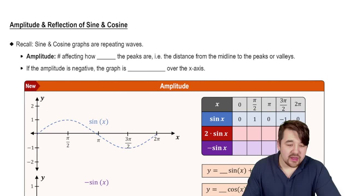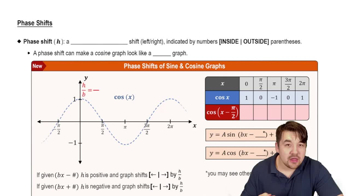Here are the essential concepts you must grasp in order to answer the question correctly.
Amplitude
Amplitude refers to the maximum height of a wave from its midline. For the sine function, it is determined by the coefficient in front of the sine term. In the function y = sin(x - π/2), the amplitude is 1, indicating that the wave oscillates between 1 and -1.
Recommended video:
Amplitude and Reflection of Sine and Cosine
Period
The period of a trigonometric function is the length of one complete cycle of the wave. For the sine function, the standard period is 2π. In the function y = sin(x - π/2), there is no coefficient affecting the x term, so the period remains 2π.
Recommended video:
Period of Sine and Cosine Functions
Phase Shift
Phase shift indicates how much the graph of a function is horizontally shifted from its standard position. In the function y = sin(x - π/2), the phase shift is π/2 units to the right, as indicated by the subtraction of π/2 from x. This shift affects the starting point of the sine wave.
Recommended video:
 Blitzer 3rd Edition
Blitzer 3rd Edition Ch. 2 - Graphs of the Trigonometric Functions; Inverse Trigonometric Functions
Ch. 2 - Graphs of the Trigonometric Functions; Inverse Trigonometric Functions Problem 18
Problem 18 Verified step by step guidance
Verified step by step guidance


